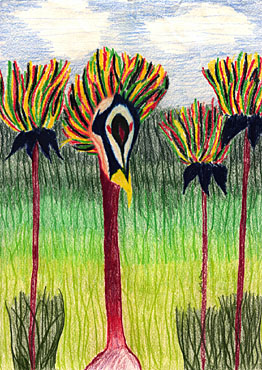Mimi Bird

by
Ryoko Oono
![]()
Mimi Bird

by
Ryoko Oono
![]()
The Mimi bird of Kenya, Africa, lives among the Jamaikan Cosmos which helps it to camouflage. The Jamaikan Cosmos grows inbetween tall prairie grass, their stem is magenta colored, same as the Mimi's neck, the sepal is colored indigo blu
e, like the Mimi's face, and the petals are black, yellow, red, and green, much like the feathers on top of the Mimi's head.
The Mimi uses its strong yellow beak to pull out the roots of prairie grass to eat. It also uses its muscular long legs to dig holes. The Mimi huddles itself in the burrow that it makes to rest or raise their young ones. The baby Mimi does not have such c
olorful feathers on their heads. About two weeks after birth, baby Mimis grow yellowish-green feathers on their head. Soon it turns to darker green as the Mimi grows, then by the time they are the same height as the Jamaikan Cosmos, they will grow black f
eathers, then red and yellow.
Male Mimis differ from female Mimis. Female Mimis are about 3 inches shorter than the male Mimis, and they do not have colorful feathers on their head. Females stop to grow when they have dark green feathers on their head.
The Mimis live together as a family, and all the Mimi birds in the region live in one area and looks out for one another. The male Mimis have a job to make a home for its family and to provide food.
The Mimi birds can fly, but hardly does because if they do, their predators can find the nests and then a whole Mimi village could be wiped out. They run very fast but only on open plains.
The mimi birds converse with each other in several different ways. One way is by their vocal cries, scientists think the vocal cries are used to warn someone or to scare away some creatures. Second way of communication is by using their body and wings. Op
ening their wings mean enjoyment of happiness, sometimes it is a way to show off how large they are or to show the importance of himself or herself. Last way to communicate is by the movement of the head. Any movement of the head means some kind of anger,
such as to fight or jealousy.
For every bird, the mask-like face is somewhat different. The Northern Kenya Mimi birds have a peach colored ring around their head, and for Southern birds, they have a lemon-yellow colored wrigged ring around their face. In this way all Mimi birds have a
different type of light colored ring around their face.